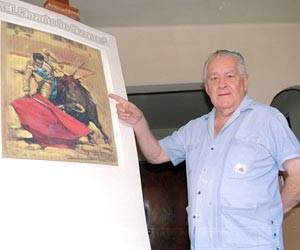Barrera Taurina…rumors, half-truths, and anything in between…
Casa Toreros, the management group for Tijuana’s Plaza Monumental de Playas, presented the outline of the summer temporada in the “Bullring by the Sea”. It will open with a special corrida this Sunday, April 12, featuring the return of the greatest (horseback bullfighter) Spanish maestro Pablo Hermoso de Mendoza, who will perform with two bulls of the Los Encinos herd, while, on foot, veteran capitalino Federico Pizarro, in a renaissance of the class and artistic inspiration that animated the first years of his career, and the next to youngest member of the Sanchez dynasty of Aguascalientes, Juan Pablo Sanchez, will confront four bulls from the Pozo Hondo ranch of Zacatecas.
The season will take a break in May and resume the second week of June, with two corridas a month—a possible total of “7 or 8”—until September. No specific cartels were announced at the March 23rd conference, but the names of Joselito Adame, Mexico´s current international figure, and Diego Silveti, son of the late, great David ´´El Rey´´ Silveti, as having been signed, and a number of “international names¨ were hinted at, but not revealed. There are unsubstantiated rumors of a slightly extended season that would run into the early fall and feature several of the Spanish stars as they return to Mexico for the winter tours, but nothing was—or is likely to be—confirmed any time soon.
Prices for the best shady side seats will increase slightly from the current $96 to approximately $102, Shady Side general admission will cost 250 pesos (approximately $17). The Sunny Side general seats will not be sold, cutting down on the unfortunate appearance of a half-empty plaza which disguises a crowd that in almost any other plaza in the country would be considered a success.

Renowned taurine painter and Tijuana resident Reynaldo Torres, whose iconic art work illustrated many of the past half-century’s cartels (bullfight posters) has died of liver failure at the age of 82.
Torres’ art has been widely disseminated and he, along with contemporaries Pancho Flores and Antonio Navarrette, formed the leading triumvirate of taurine advertising art in what was, perhaps, the most financially successful era of Mexican toreo, the late 1940’s up to the 1980’s era of Martinez, Cavazos, Rivera and Ramos.
Torres’ work is instantly recognizable for its impressionist-like dynamism, bright, quintes-sentially Mexican palette, and recognizable portraiture. He also illustrated album covers of such musical greats as Agustin Lara.
He was born in Tijuana in 1932, but moved to Mexico, D.F., in 1957, where he maintained his studio and home. His most famous piece is a portrait of revolutionary Spanish matador Juan Belmonte, and a number of his works are on permanent display at the headquarters office of the Matador’s Association of Mexico.
Spanish matador Ivan Fandino’s gesta (grand gesture) of taking on 6 bulls from 6 different ganaderias—all of them famous for sending “hard” bulls, or bulls which can be unpredictable, often dangerous, always extremely well-armed, and, occasionally, extraordinarily brave—for the opening corrida of the 2015 Madrid/Las Ventas temporada, was a complete flop in every context except—notably, the gate, which registered a complete sell-out.
That statistic was a happy enough detail, especially as it concerned a taurine event outside of the required corridas that all season ticket holders must purchase, coming on the first day of the season, for an as yet “unconsolidated” matador.
Fandino, who, since his unlikely emergence from the taurinely illiterate town of Orduna in the north, has inspired great respect and even passion from all quarters of the bull world, seemed overpowered by the responsibility of the event, which he and his manager had proposed to Taurodelta, the managing group of Las Ventas, and when the bulls turned out—surprise—less than cooperative, or, at least, less than spectacular—the afternoon crumbled beneath it’s own, perhaps, exaggerated expectations.
No ears were cut, no vueltas (celebratory turns of the ring following good performances) asked for or taken, not even a call to the tercio to acknowledge a solid effort. As with any grand gesture, the risk to the principals—ranchers as well as toreros—is understood beforehand.
The ganaderos, however, have much less at stake and are always able to blame the inherent vagaries of the art/science/witchcraft of breeding bulls; Fandino, whose entire career has been predicated upon answering the bell and making something happen even in the face of significant opposition—human or animal—has to be worried. Madrid was willing to support him to the tune of a full plaza and a generally positive disposition—until the fourth bull, of the famous Adolfo Martin ranch—where their forbearance ran out.
Fandino has double opportunities in Sevilla and San Isidro in Madrid in May to right the ship, something that will—in this reporter’s humble opinion—simply serve to prove that his vaunted authenticity, sense of seriousness and noblesse oblige is not an act.





